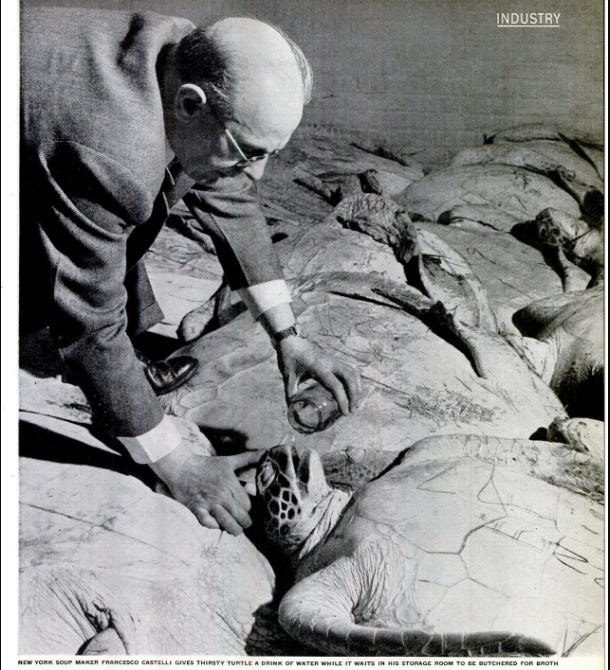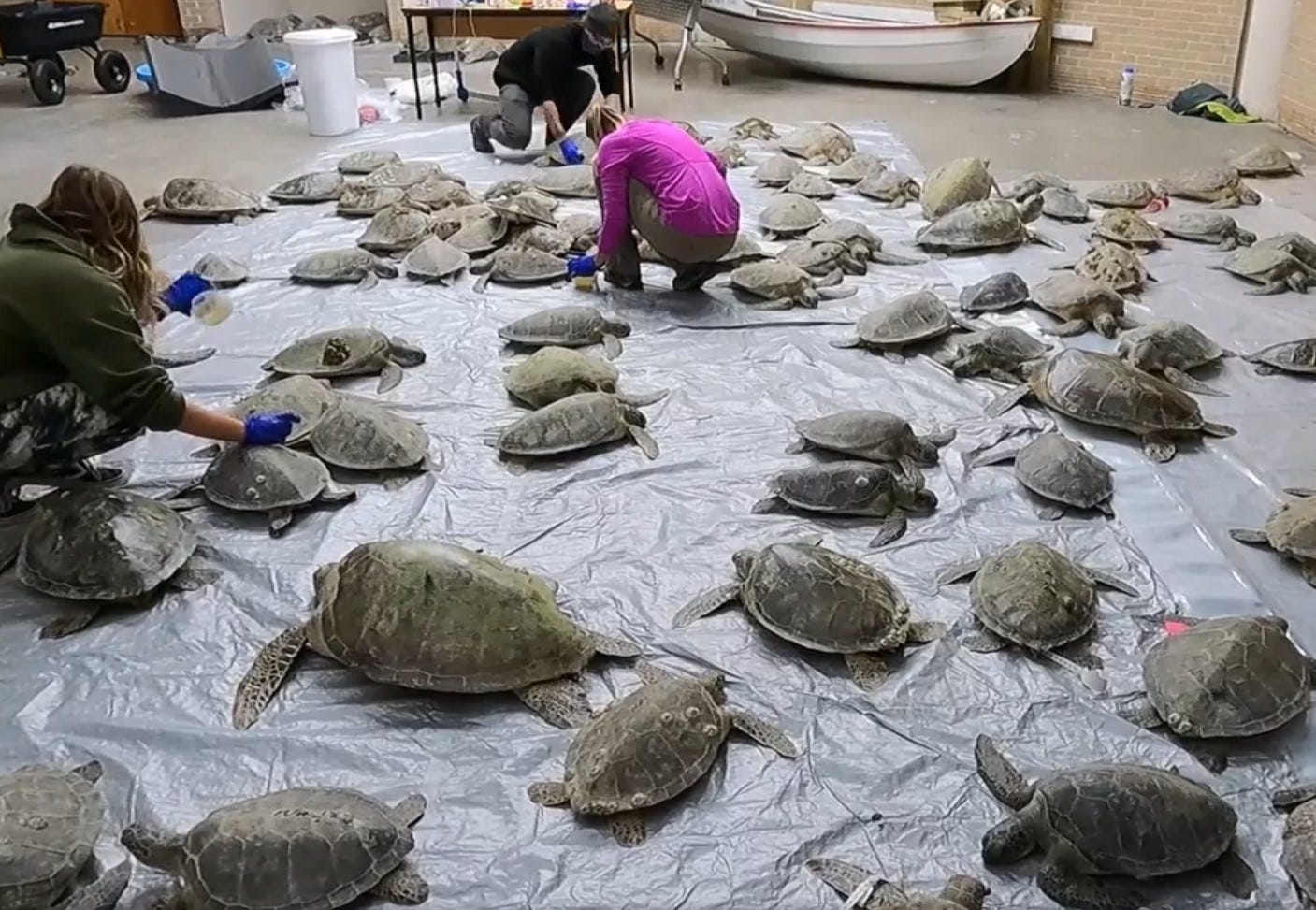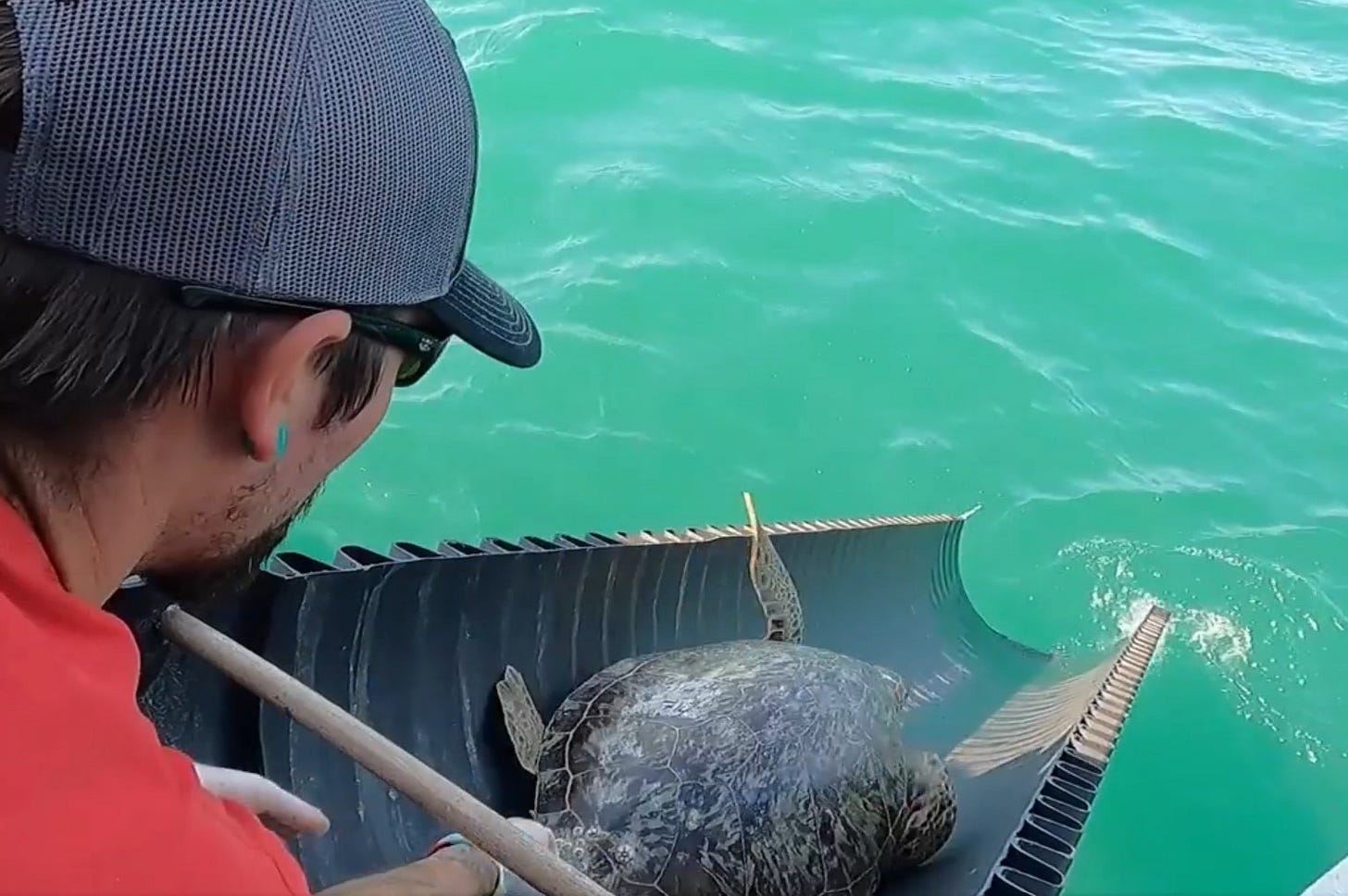The silver lining to the most shocking recipe possibly ever published in Life Magazine
A photo of sea turtles lined up in a room used to mean something quite different than it does now
If you were to drive to Roberts Point Park in Port Aransas, Texas, right this minute, you’d likely encounter a flotilla of green sea turtles foraging on sea grass. Among oil tankers, shrimp boats, two car ferries and countless fishermen, they are thriving.
It wasn’t always this way. For a few decades, they all but disappeared from the South Texas Gulf Coast, which is where I grew up. As a kid, I thought this was because they often got trapped in shrimpers’ nets, a problem known as bycatch (which was solved with the invention of turtle excluder devices). I also knew about habitat loss and subsequent light pollution, which can confuse hatchlings that look for moonbeams reflecting off the ocean and see houselights instead.
Those things certainly didn’t help. But as I recently learned, the chief reason is far more unsettling. “Hunting” is too kind a word for it, as that (thankfully) implies some measure of conservation and/or regulations in place. Instead, it was more like a decades-long plundering, and an incredibly cruel form of it to boot.
‘Gloomy reptiles wait to be made into broth’
I stumbled upon the backstory while researching a mysterious and disturbing family photo of a massive leatherback sea turtle (detailed in my essay Head Wounds, published in The San Antonio Review).
This detective work required thumbing through files labeled “sea turtle” at the Corpus Christi Public Library archives. A lot of it was depressing, but a 1947 Life Magazine article titled “Turtle Soup” made me gasp.
The article introduces us to Francesco Castelli, the “tender-hearted” president of Moore and Co. Soups, a New York company that annually rendered thousands of sea turtles in the first half of the 20th century.
“Rendered” as in shipped alive from places like Florida and Texas, then kept in a room by the hundreds, all flipped over on their backs, dying and dehydrated, occasionally attended to by Mr. Castelli, as shown in this heartbreaking photo:

He had his regrets, at least. “Sometimes I’m in my office late at night,” Mr. Castelli said. “And I hear the turtles sighing in the next room and I don’t know. I just don’t know.”
Whoa, right?
It gets worse. The article includes a recipe for sea turtle soup, which I’ll not parse out here, because it uses verbs like “decapitate” and “hack.” Step-by-step photos are included I guess in case anyone wanted to cook a 200-pound sea turtle at home, a process that takes “two fourteen-hour days.”
Readers learn sea turtle soup is used widely for hospitalized patients, along with the tip “it is also good for hangovers.” As for how the turtles feel about it, we’re told they “stare reproachfully” at the cooks. They also are described as “melancholy,” “gloomy” and “meek,” as if they’d behave any other way on their way to the slaughterhouse.
Turns out sea turtles are not a sustainable food source
In the same archive, articles about turtle canning and harvesting eventually gave way to alarm. In articles from the late 1950s and 60s, people are beginning to wonder: Where are all the sea turtles? Even as early as the 1960s NOAA scientists were using satellites to track radio-collared Texas sea turtles to reestablish populations, a sophisticated technology I had no idea was available back then, especially not for wildlife.
It’s not clear if there was a tipping point that got sea turtles off menus. Along with the dawning of the environmental and animal rights movements of the late 20th century, scarcity likely played a big role, plus the inability to raise and butcher them as easily as land-based sources of meat.
The pendulum has swung so far in the other direction that basically no one in the US eats reptiles on a regular basis anymore, except for a few communities sprinkled across the South and Appalachia, notably New Orleans, where I recently spotted turtle soup (presumably freshwater) on a menu, next to fried alligator.
From menu item to oceanic ambassador
Once sea turtles fell out of culinary favor, they didn’t exactly rebound. They needed help. As a human being, I’m proud to say we didn’t just stand by and watch them go extinct. We swung into action. All over the world there are now conservation programs in place, including several in the Corpus Christi area that I support.
Like the wonderful Amos Rehabilitation Keep, where injured sea turtles (and other critters) are nursed back to health. The ARK’s release events are attended by hundreds of curious tourists delighted by the mystical appeal of sea turtles.
A little farther south, at Padre Island National Seashore, staff meticulously patrol the beach each summer, looking for signs that the world’s most critically endangered sea turtle, the Kemp Ridley, has come ashore and laid eggs. When a nest is found, staff collect the eggs and incubate them under ideal conditions. And just like with ARK events, hordes of people come to watch the hatchlings get released weeks later.
Saving cold-stunned turtles by the thousands
In February 2021, during the height of the pandemic—when the vaccines were delayed, when many Texans died in a winter storm, when the White House was recovering from the insurrection—there was one video genre in particular that I watched over and over: Sea turtles sliding into home… literally.
Not long ago, this many sea turtles on a boat or piled up in a room would have meant they were headed to a grim ending.
Now, though, it means they’re not headed for rendering, but release.

It’s stories like this that give me hope on a sad day. And 2021 was filled with sad days. There’s something about the resilience of animals that has always given me inner strength. (It’s a major theme of my memoir-in-progress.) Learning the history of sea turtles was nauseating, but at least I have the advantage of being alive now, when it’s obvious we’ve righted our wrongs. Yes, sometimes we seem doomed to repeat our mistakes, but sometimes we learn from them, too.





The report about the turtles crying still haunts me from the first time I read it, when you sent me the draft. So brutal. Whenever I read about things like that my mind simply cannot go to.. it was a different time. I just cannot wrap my head around how oblivious people were to their suffering. I know we have a certain amount of privilege, looking through our modern lens. But STILL. Egads.